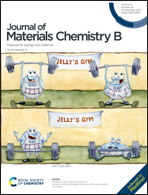Carbon nanotube-reinforced cell-derived matrix-silk fibroin hierarchical scaffolds for bone tissue engineering applications
Abstract
In bone tissue engineering, the development of advanced biomimetic scaffolds has led to the quest for biomotifs in scaffold design that better recreate the bone matrix structure and composition and hierarchy at different length scales. In this study, an advanced hierarchical scaffold consisting of silk fibroin combined with a decellularized cell-derived extracellular matrix and reinforced with carbon nanotubes was developed. The goal of the carbon nanotube-reinforced cell-derived matrix-silk fibroin hierarchical scaffolds is to harvest the individual properties of their constituents to introduce hierarchical capacity in order to improve standard silk fibroin scaffolds. The scaffolds were fabricated using enzymatic cross-linking, freeze modeling, and decellularization methods. The developed scaffolds were assessed for the pore structure and mechanical properties showing satisfying results to be used in bone regeneration. The developed carbon nanotube-reinforced cell-derived matrix-silk fibroin hierarchical scaffolds were shown to be bioactive in vitro and expressed no hemolytic effect. Furthermore, cellular in vitro studies on human adipose-derived stem cells (hASCs) showed that scaffolds supported cell proliferation. The hASCs seeded onto these scaffolds evidenced similar metabolic activity to standard silk fibroin scaffolds but increased ALP activity. The histological staining showed cell infiltration into the scaffolds and visible collagen production. The expression of several osteogenic markers was investigated, further supporting the osteogenic potential of the developed carbon nanotube-reinforced cell-derived matrix-silk fibroin hierarchical scaffolds. The hemolytic assay demonstrated the hemocompatibility of the hierarchical scaffolds. Overall, the carbon nanotube-reinforced cell-derived matrix-silk fibroin hierarchical scaffolds presented the required architecture for bone tissue engineering applications.



 Please wait while we load your content...
Please wait while we load your content...